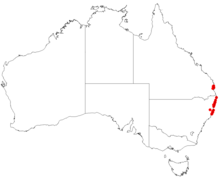| Allocasuarina thalassoscopica | |
|---|---|

| |
| Conservation status | |
 Endangered (EPBC Act) | |
| Scientific classification | |
| Kingdom: | Plantae |
| Clade: | Tracheophytes |
| Clade: | Angiosperms |
| Clade: | Eudicots |
| Clade: | Rosids |
| Order: | Fagales |
| Family: | Casuarinaceae |
| Genus: | Allocasuarina |
| Species: | A. thalassoscopica |
| Binomial name | |
| Allocasuarina thalassoscopica L.A.S.Johnson | |

| |
| Occurrence data from AVH | |
| Synonyms | |
| |

Allocasuarina thalassoscopica is a species of flowering plant in the family Casuarinaceae and is endemic to eastern Australia. It is a spreading to erect, dioecious shrub that has branchlets up to 180 mm (7.1 in) long, the leaves reduced to scales in whorls of five to seven, the fruiting cones 12–28 mm (0.47–1.10 in) long containing winged seeds 4.0–8.0 mm (0.16–0.31 in) long.
Description
Allocasuarina thalassoscopica is a spreading to erect, dioecious shrub that typically grows to a height of 0.5–1.5 m (1 ft 8 in – 4 ft 11 in) and has smooth or fissured bark. Its branchlets are up to 120 mm (4.7 in) long, sometimes to 180 mm (7.1 in) long, the leaves reduced to scale-like teeth 0.3–0.6 mm (0.012–0.024 in) long, arranged in whorls of five to seven around the branchlets. The sections of branchlet between the leaf whorls are 3–12 mm (0.12–0.47 in) long, 0.5–0.9 mm (0.020–0.035 in) wide. Male flowers are arranged in spikes 5–45 mm (0.20–1.77 in) long, with mostly 6 to 10 whorls per centimetre (per 0.39 in.), the anthers 0.5–1.0 mm (0.020–0.039 in) long. Female cones are on a peduncle 3–14 mm (0.12–0.55 in) long, and mature cones 12–28 mm (0.47–1.10 in) long and 8–18 mm (0.31–0.71 in) in diameter, containing dark brown to blackish, winged seeds 4.0–8.0 mm (0.16–0.31 in) long.
Taxonomy
Allocasuarina thalassoscopica was first described in 1989 by Lawrie Johnson in the Flora of Australia. The specific epithet, (thalassoscopica) means "sea-watcher", referring to its situation on a mountain slope, facing the sea.
Distribution and habitat
This she-oak forms a dense, low, closed heath on the windswept south-facing upper slopes of Mount Coolum and along the coast from Noosa Heads in south-east Queensland to Diamond Beach in northern New South Wales.
Conservation status
Allocasuarina thalassoscopica is listed as "endangered" under the Australian Government Environment Protection and Biodiversity Conservation Act 1999, and the Queensland Government Nature Conservation Act 1992. The main threats to the species are vegetation clearing and inappropriate fire regimes.
References
- ^ "Allocasuarina thalassoscopica". Australian Plant Census. Retrieved 15 August 2023.
- ^ "Allocasuarina thalassoscopica". Australian Biological Resources Study, Department of Agriculture, Water and the Environment: Canberra. Retrieved 10 August 2023.
- Wilson, Karen L. "Allocasuarina thalassoscopica". Royal Botanic Garden Sydney. Retrieved 15 August 2023.
- ^ Wilson, Karen L.; Johnson, Lawrence A.S. (1989). George, Alex S. (ed.). Flora of Australia (PDF). Vol. 3. Canberra: Australian Government Publishing Service. p. 199. Retrieved 15 August 2023.
- "Allocasuarina thalassoscopica". APNI. Retrieved 15 August 2023.
- "Approved Conservation Advice for Allocasuarina thalassoscopica" (PDF). ustralian Government Department of Climate Change, Energy, the Environment and Water. Retrieved 15 August 2023.
- "Species profile—Allocasuarina thalassoscopica (Mt. Coolum she-oak)". Queensland Government Department of Environment and Science. Retrieved 15 August 2023.
- "Allocasuarina thalassoscopica - profile". New South Wales Government Office of Environment and Heritage. Retrieved 15 August 2023.